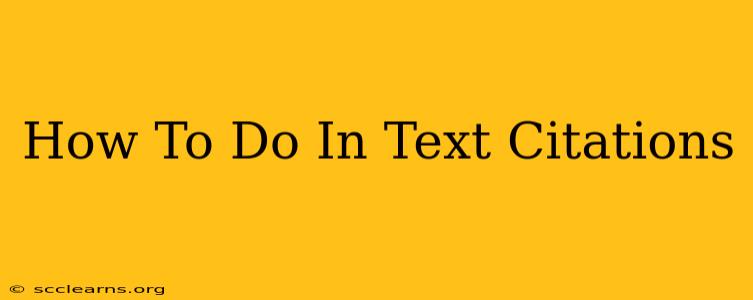In-text citations are crucial for academic writing. They give credit to your sources and avoid plagiarism. This guide provides a clear and concise explanation of how to properly cite sources within your text, covering different citation styles. Mastering in-text citations is key to producing credible and academically sound work.
Understanding In-Text Citations
In-text citations, also known as parenthetical citations, are brief references within your writing that correspond to a full citation in your bibliography or works cited page. They directly link your text to the source material, allowing readers to easily verify your information and explore your research further. The specific format varies depending on the citation style (e.g., MLA, APA, Chicago).
Why are In-Text Citations Important?
- Avoiding Plagiarism: Properly citing sources is essential to avoid accusations of plagiarism, a serious academic offense. It demonstrates that you are using other people's work ethically and responsibly.
- Building Credibility: In-text citations show that your work is based on reliable research and strengthens your argument by backing up your claims with evidence.
- Improving Clarity and Readability: Well-placed citations help your reader follow the flow of your argument and easily identify the source of specific information.
- Supporting Academic Integrity: In-text citations are fundamental to maintaining academic honesty and contributing to the ethical landscape of scholarship.
Common Citation Styles and Their Formats
Several citation styles exist, each with its own formatting rules for in-text citations. Here are some of the most frequently used:
MLA (Modern Language Association)
MLA is commonly used in the humanities. In-text citations typically include the author's last name and the page number(s) in parentheses at the end of the sentence.
Example: "Shakespeare's use of iambic pentameter is remarkable" (Shakespeare 123).
If the author's name is already mentioned in the sentence, only the page number needs to be included in parentheses.
Example: Shakespeare's use of iambic pentameter is remarkable (123).
APA (American Psychological Association)
APA style is widely used in social sciences and psychology. The basic format is similar to MLA, but it often includes the year of publication.
Example: (Author's Last Name, Year, p. Page Number). For example: (Smith, 2023, p. 45).
Chicago/Turabian
The Chicago style has two main systems: notes and bibliography, and author-date. The author-date system is similar to APA, while the notes and bibliography system uses footnotes or endnotes for citations.
Tips for Effective In-Text Citation
- Consistency is Key: Maintain consistent formatting throughout your entire paper.
- Accuracy is Paramount: Double-check all your citations for accuracy to ensure that the information in the in-text citation matches the information in your bibliography or works cited page.
- Context is Important: Place citations appropriately within your text to clearly indicate the source of the information.
- Use a Citation Management Tool: Tools like Zotero or Mendeley can help you organize your sources and generate citations automatically.
Mastering In-Text Citations: A Path to Academic Success
By understanding the principles of in-text citation and following the guidelines of your chosen citation style, you'll significantly enhance the quality and credibility of your academic work. This skill is invaluable throughout your academic journey and beyond. Remember to always consult the official style guide for the most up-to-date and detailed information. Practice makes perfect – the more you practice, the more confident and proficient you will become in using in-text citations correctly.

